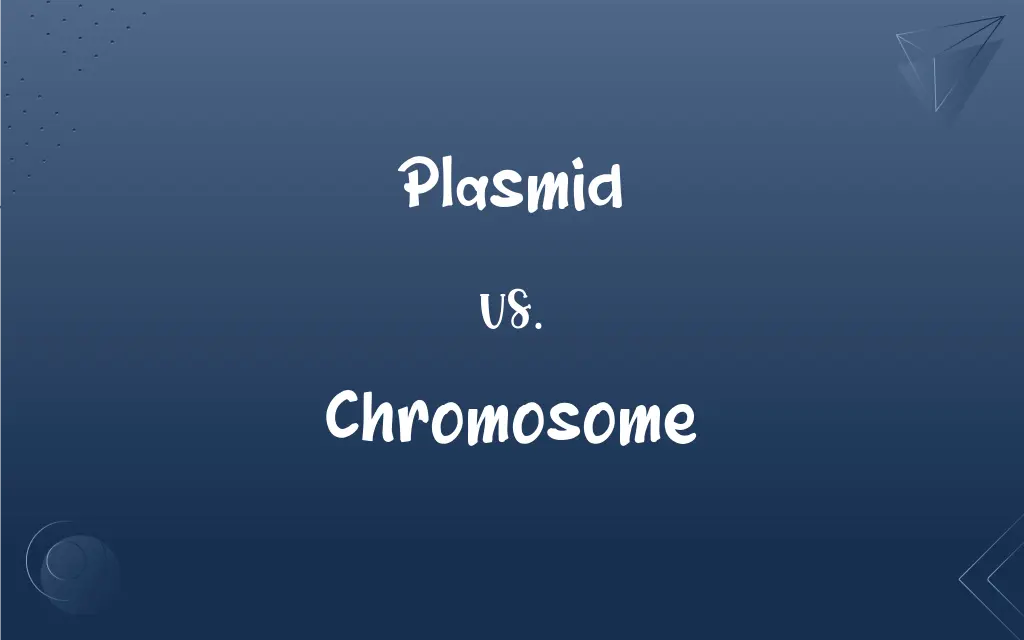Plasmid vs. Chromosome: What's the Difference?
Edited by Aimie Carlson || By Harlon Moss || Published on January 21, 2024
Plasmids are small, circular DNA molecules in bacteria, separate from chromosomes, which are larger, structured DNA carrying genetic information in cells.

Key Differences
A plasmid is a small, circular piece of DNA found primarily in bacteria, separate from the chromosomal DNA. In contrast, a chromosome is a long, linear or circular DNA molecule that constitutes the majority of the genetic material in a cell, found in both prokaryotic and eukaryotic organisms.
Plasmids often carry genes that can be beneficial for bacterial survival, such as antibiotic resistance genes. Chromosomes, on the other hand, contain the essential genes necessary for the normal growth, development, and functioning of an organism.
Plasmids are known for their ability to be transferred between different bacterial cells, a process important in genetic engineering. Chromosomes are typically fixed within a cell and are passed from parent to offspring during reproduction.
In terms of size, plasmids are much smaller than chromosomes and have a simpler structure. Chromosomes are larger and more complex, often containing regulatory elements and introns in addition to coding sequences.
Plasmids are not essential for basic cell function and survival, they can confer adaptive advantages in specific environments. Chromosomes are essential for the survival of cells, containing genes that dictate the organism's hereditary traits.
ADVERTISEMENT
Comparison Chart
Structure
Small, circular DNA molecules
Larger, linear or circular DNA molecules
Location
Mainly in bacteria, separate from chromosomes
In the nucleus or nucleoid of all cells
Gene Content
Often carry non-essential, beneficial genes
Contain essential genes for growth and function
Transferability
Can be transferred between cells
Fixed, passed down during reproduction
Importance for Survival
Not essential for survival, but offer advantages
Essential for survival and hereditary information
ADVERTISEMENT
Plasmid and Chromosome Definitions
Plasmid
A plasmid is a small, circular DNA molecule found in bacteria.
Scientists used a plasmid to introduce a new gene into bacterial cells.
Chromosome
A chromosome is a long DNA molecule that contains genetic information.
Human cells typically have 23 pairs of chromosomes.
Plasmid
Plasmids often carry genes beneficial for bacterial adaptation and survival.
The bacteria's resistance to antibiotics was due to a gene in its plasmid.
Chromosome
Chromosomes carry genes essential for growth, development, and function.
Genetic disorders are often caused by mutations in genes on chromosomes.
Plasmid
Plasmids can replicate independently within bacterial cells.
The replication of the plasmid ensured the spread of its genes among bacteria.
Chromosome
Each species has a characteristic number of chromosomes.
Fruit flies have four pairs of chromosomes in each cell.
Plasmid
Plasmids are separate from a bacterium’s main chromosome.
The plasmid in the bacterial cell contained different genes than its chromosome.
Chromosome
Chromosomes are found in the nucleus of eukaryotic cells.
During cell division, the chromosomes in the nucleus become visible under a microscope.
Plasmid
Plasmids are used in genetic engineering due to their transferability between cells.
Gene cloning techniques often involve inserting genes into plasmids.
Chromosome
Chromosomes consist of DNA wrapped around protein structures.
Chromosomal DNA is tightly packed around histones to fit within the cell nucleus.
Plasmid
A circular, double-stranded unit of DNA that replicates within a cell independently of the chromosomal DNA. Plasmids are most often found in bacteria and are used in recombinant DNA research to transfer genes between cells.
Chromosome
A linear strand of DNA and associated proteins in the nucleus of eukaryotic cells that carries the genes and functions in the transmission of hereditary information.
Plasmid
(cytology) A loop of double-stranded DNA that is separate from and replicates independently of the chromosomes, most commonly found in bacteria, but also in archaeans and eukaryotic cells, and used in genetic engineering as a vector for gene transfer.
Chromosome
A circular strand of DNA in bacteria and archaea that contains the hereditary information necessary for cell life.
Plasmid
A piece of DNA, usually circular, functioning as part of the genetic material of a cell, not integrated with the chromosome and replicating independently of the chromosome, but transferred, like the chromosome, to subsequent generations of daughter cells. In bacteria, plasmids often carry the genes for antibiotic resistance; they are exploited in genetic engineering as the vehicles for introduction of extraneous DNA into cells, to alter the genetic makeup of the cell. The cells thus altered may produce desirable proteins which are extracted and used; in the case of genetically altered plant cells, the altered cells may grow into complete plants with changed properties, as for example, increased resistance to disease.
Chromosome
A linear arrangement of condensed DNA and associated proteins (such as chaperone proteins) which contains the genetic material (genome) of an organism.
Chromosomes store genetic information.
Plasmid
A small cellular inclusion consisting of a ring of DNA that is not in a chromosome but is capable of autonomous replication
Chromosome
One of the minute bodies into which the chromatin of the nucleus is resolved during mitotic cell division; the idant of Weismann.
Chromosome
A threadlike body in the cell nucleus that carries the genes in a linear order
FAQs
What is a plasmid?
A small, circular DNA molecule, typically found in bacteria.
Where are chromosomes located?
In the nucleus of eukaryotic cells or the nucleoid of prokaryotic cells.
What do chromosomes contain?
Essential genes necessary for an organism's growth, development, and function.
What type of genes do plasmids carry?
Often genes beneficial for bacterial adaptation, like antibiotic resistance.
Can plasmids be transferred between cells?
Yes, plasmids can be transferred between different bacterial cells.
Are chromosomes transferable like plasmids?
No, chromosomes are fixed within a cell and passed during reproduction.
Where are plasmids found?
Mainly in bacteria, separate from the main chromosomal DNA.
Are plasmids essential for bacterial survival?
Not always essential, but they can offer adaptive advantages.
What role do plasmids play in genetic engineering?
Plasmids are used to transfer genes between cells in genetic engineering.
What is a chromosome?
A long DNA molecule containing genetic information, found in all cells.
How do plasmids differ in size from chromosomes?
Plasmids are much smaller and simpler compared to chromosomes.
Can plasmids replicate independently?
Yes, plasmids can replicate independently within bacterial cells.
How are chromosomes replicated?
Chromosomes are replicated during cell division processes like mitosis and meiosis.
What is the importance of chromosomes for survival?
Chromosomes are essential for the survival, containing vital genetic information.
What is the typical number of chromosomes in human cells?
Human cells usually have 46 chromosomes, or 23 pairs.
Do plasmids exist in human cells?
Plasmids are not typically found in human cells; they are common in bacteria.
How are plasmids and chromosomes similar?
Both plasmids and chromosomes are made of DNA and carry genetic information.
How are genetic disorders related to chromosomes?
Genetic disorders often result from mutations in genes located on chromosomes.
Are plasmids used in medicine?
Yes, plasmids are used in developing gene therapies and vaccines.
Do chromosomes vary between species?
Yes, each species has a characteristic number and structure of chromosomes.
About Author
Written by
Harlon MossHarlon is a seasoned quality moderator and accomplished content writer for Difference Wiki. An alumnus of the prestigious University of California, he earned his degree in Computer Science. Leveraging his academic background, Harlon brings a meticulous and informed perspective to his work, ensuring content accuracy and excellence.
Edited by
Aimie CarlsonAimie Carlson, holding a master's degree in English literature, is a fervent English language enthusiast. She lends her writing talents to Difference Wiki, a prominent website that specializes in comparisons, offering readers insightful analyses that both captivate and inform.






































































